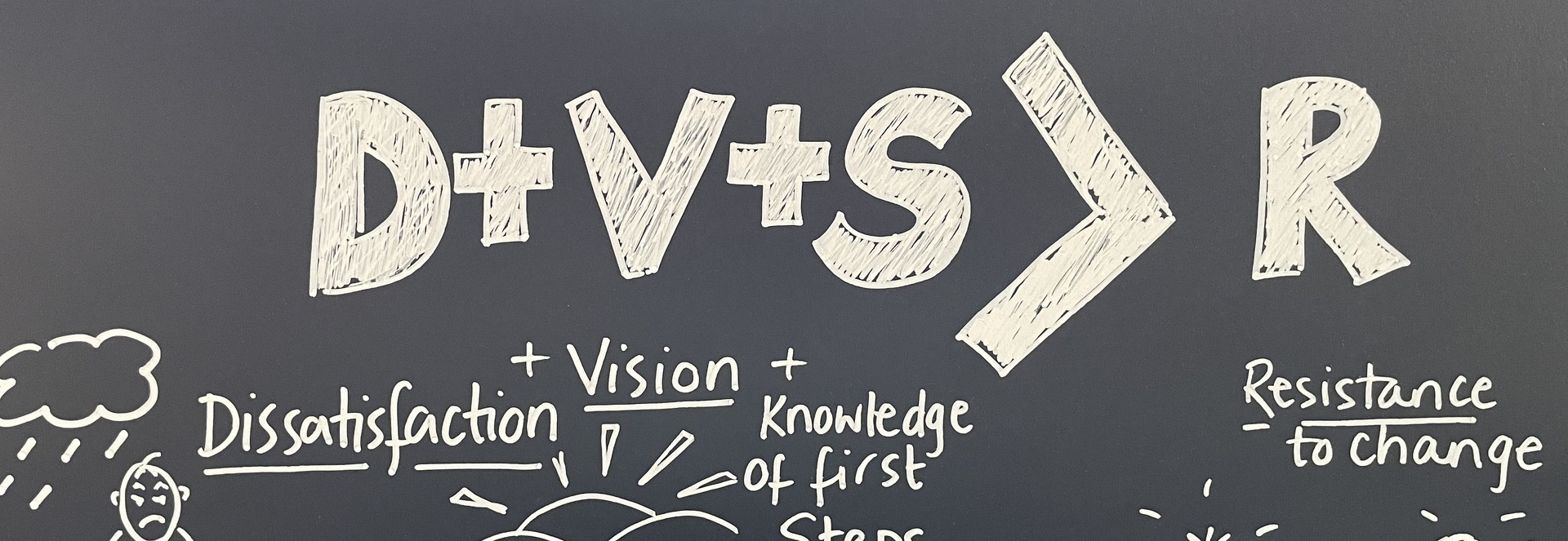The Change Equation

The Change Equation
I first came across this model well over 20 years ago but I still really value its logical simplicity and I continue to think it has a lot to offer as a tool for working with teams going through change. It also works brilliantly on a personal level as a tool for helping me think through challenging change situations, such as should I leave my job? Should we move house? etc.
Working through each of the sections, considering the impllications of each area and recording all ideas and opinions is crucial to the success of this tool.
Dissatisfaction - What is wrong with the now? What is sucking people’s energy and their enthusiasm for the job? What areas of practice are under par? On a personal level, why might people feel demoralised or disillusioned? As a team, what’s not working?
Getting a really clear picture of all these aspects can be the first constructive step towards improvement. Rather than being a moaning shop, this can be used as a catalyst for change.
Vision - what is the dream or ideal scenario? What aspects need to change and how? What will make people feel energised, enthused and motivated to do their job? What would the dream team look like? How would people feel in this dream scenario?
There is a wealth of research to demonstrate the power of visualisation or dreaming. When we create a clear and compelling picture of a future we would like to see for ourselves, we take the first step towards actualisation. Collective visioning or dreaming (as a team, organisation or common interest group) is incredibly powerful. It helps to foster mutual understanding, shared goals and a spirit of togetherness.
(First) Steps - what can each of us do today or tomorrow or in the next few days to help us move towards the dream? Who else needs to be on board? What skills or resources do we need to access to enable this to happen?
Knowledge of the first steps is vital. However small, these steps should be identified and recorded. Everyone needs to know what is to be done, when and by whom.
These three aspects, added together, will give the impetus for change. Dissatisfaction with the now gives the push, whilst the vision gives the pull. Knowledge of the first steps is the bridge between the two.
However, it isn’t as simple as that. If it were, change (organisational or personal) would be a much simpler to achieve. We also need to take account of any real or potential resistance to change.
Resistance - What or who is standing in the way? (Are these people in the room or external people or factors?) What are the obstacles that might hinder our progress? What attitudes or behaviours (in ourselves or others) are we going to have to tackle in order to succeed?
Dissatisfaction, vision and knowledge of first steps must be greater than the resistance to change. It doesn’t mean the resistance will disappear but its impact needs to shrink back so that that positive energy of the vision can take over.
You can keep working on each aspect of the equation to ensure that the three left-hand values are compelling enough to overcome the right-hand value. As a facilitator, I have used this really effectively as a framework for strategic planning over a whole day. It then offers a great reflective starting point for coming back together to review progress towards the desirable future.
Contact me at helen@envision-uk.org if you would like to know more or talk about how this could work with your team.

Tagged as: Change management, External facilitation, Graphic Facilitation, Independent facilitation, Leadership, Team Days
Share this post:





